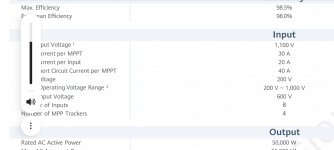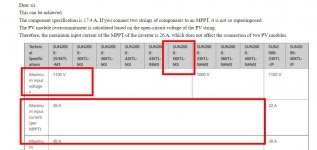Hi all,
A 50 kw grid tied inverter has the specs according to the attached picture. It's a Huawei 50 KW
On the Huawei 50KTL-M3 inverter datasheet
Max current per mppt 30A,
Max current per input 20A.
Max short circuit per MPPT 40A
What if we have two strings connected with the two inputs of 1 MPPT.
The specs of the PV Module are
Impp 17.4 A
ISc 18.52 A
550 Wp mono
2 x 17.4 A = 34.8 A
What do you guys think about this?
A 50 kw grid tied inverter has the specs according to the attached picture. It's a Huawei 50 KW
On the Huawei 50KTL-M3 inverter datasheet
Max current per mppt 30A,
Max current per input 20A.
Max short circuit per MPPT 40A
What if we have two strings connected with the two inputs of 1 MPPT.
The specs of the PV Module are
Impp 17.4 A
ISc 18.52 A
550 Wp mono
2 x 17.4 A = 34.8 A
What do you guys think about this?



